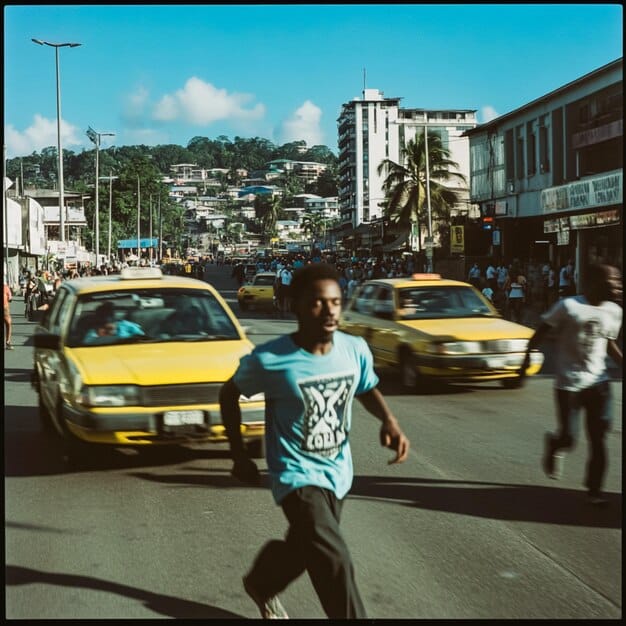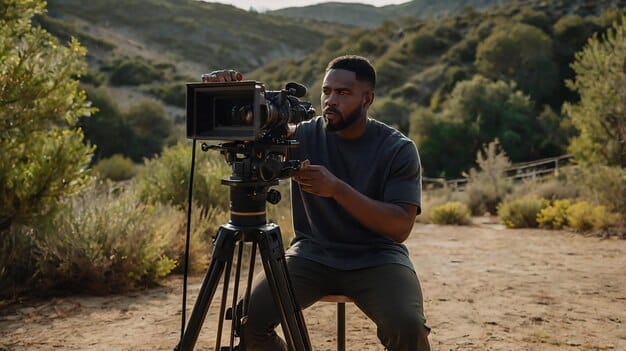Brazilian Documentary: Trends, Challenges, Funding Opportunities

Brazilian documentary filmmaking is navigating a dynamic landscape, marked by evolving artistic trends, persistent production and distribution challenges, and a complex array of funding mechanisms crucial for its continued development and global recognition.
Delving into the world of Documentary Filmmaking in Brazil: Trends, Challenges, and Funding Options reveals a vibrant, complex, and deeply impactful artistic landscape. This is a sphere where raw reality meets creative vision, often against a backdrop of socioeconomic nuances unique to Brazil. But what truly defines this evolving cinematic form, and how does it navigate the intricate pathways of production and financial support?
The Evolving Landscape of Brazilian Documentary
Brazilian documentary cinema has long been a powerful voice, reflecting the nation’s diverse narratives, social complexities, and cultural richness. From the groundbreaking political films of the 1960s to contemporary explorations of identity and environment, the genre has consistently adapted to changing times and technologies. Today, Brazilian documentaries are charting new territory, embracing innovative storytelling techniques and exploring a broader spectrum of themes.
A significant trend observable in recent years is the increasing democratization of filmmaking tools. Affordable digital cameras and editing software have empowered a new generation of filmmakers, allowing for more agile and experimental productions. This accessibility has led to a surge in independent projects that often bypass traditional industry gatekeepers, fostering a more diverse and authentic cinematic output. This shift is not just about technology; it’s about giving voice to previously underrepresented communities and perspectives.
Emerging Thematic Trends
The narratives being explored in Brazilian documentaries are as diverse as the country itself. Filmmakers are increasingly focusing on themes that resonate with profound social and environmental issues, bringing critical discussions to the forefront. This thematic evolution reflects a growing awareness and desire to use cinema as a tool for advocacy and understanding.
- Environmental Crisis: Documentaries frequently explore the destruction of the Amazon, the impact of mining, and the struggles of indigenous populations defending their lands.
- Social Justice and Inequality: Films delve into urban violence, racial discrimination, LGBTQIA+ rights, and the legacy of historical injustices, offering poignant human stories.
- Cultural Identity: There’s a renewed interest in regional cultures, forgotten traditions, and the complex tapestry of Brazilian identity, often interwoven with music, dance, and folklore.
Beyond content, the aesthetic trends are also evolving. Many filmmakers are experimenting with hybrid forms, blending documentary with elements of fiction, animation, or experimental cinema. This blurring of lines allows for more nuanced interpretations of reality, inviting audiences to engage on a deeper, more emotional level. The stylistic choices are often informed by the subject matter, creating a powerful fusion of form and content.
For instance, some documentaries are adopting a more participatory approach, involving the subjects themselves in the storytelling process, which adds layers of authenticity and removes the traditional barrier between filmmaker and filmed. This collaborative spirit is reshaping how stories are told and experienced, moving beyond simple observation to active engagement. The result is a richer, more multifaceted representation of Brazilian life.
Persistent Challenges in Documentary Production
Despite the artistic vitality and innovative spirit within Brazilian documentary filmmaking, the sector faces a litany of persistent challenges. These obstacles often impede production, limit distribution, and make it difficult for filmmakers to sustain their careers. Understanding these hurdles is crucial for anyone looking to navigate or support the industry.
One of the most significant challenges is funding instability. Brazilian cultural policies and funding mechanisms have historically been subject to political fluctuations, leading to unpredictable support for audiovisual projects. This uncertainty makes long-term planning incredibly difficult for production companies and individual filmmakers. Projects can be stalled indefinitely due to shifts in government priorities or the sudden unavailability of previously allocated funds. This unpredictability creates a precarious environment for creative work.
Navigating Distribution Limitations
Once a documentary is produced, getting it seen by audiences presents another formidable challenge. Brazil, with its vast geographical expanse and diverse population, has an uneven distribution infrastructure. While major cities may have independent cinemas and cultural centers, reaching audiences in remote areas or those outside the traditional film circuits remains a significant hurdle. This limits the film’s social impact and economic viability.
- Limited Theatrical Release: Many documentaries struggle to secure widespread theatrical distribution, often relegated to niche festivals or limited art-house runs.
- Digital Platform Competition: While streaming platforms offer new avenues, securing deals can be competitive, and the revenue share might not be sustainable for smaller productions.
- Audience Engagement: Building and maintaining an audience for documentary films requires sustained promotional efforts, which are often beyond the financial reach of independent filmmakers.
Beyond distribution, censorship and political pressures have, at various points, cast a shadow over documentary output. Films that critically examine social or political issues can face scrutiny, making filmmakers cautious about tackling controversial subjects. This self-censorship, whether perceived or explicit, can stifle creative freedom and limit the breadth of narratives explored. The current political climate often dictates the boundaries of what can be openly discussed.

Furthermore, the high cost of production, even with advances in digital technology, remains a barrier. Securing equipment, travel, crew salaries, and post-production services requires substantial investment. Without consistent and robust funding, many ambitious projects never get off the ground, or they compromise their artistic vision due to budget constraints. This financial strain disproportionately affects emerging filmmakers and those from marginalized backgrounds, perpetuating a lack of diversity in the industry. The challenges are multifaceted, requiring a comprehensive approach to overcome them effectively.
Understanding Funding Options for Documentaries
Funding is the lifeblood of documentary filmmaking, and in Brazil, it stems from a mix of public, private, and international sources. Navigating this landscape requires not only a compelling project but also a deep understanding of each funding body’s priorities and application processes. Access to capital dictates not only the scope of a film but also its very possibility.
Historically, public funding has been a cornerstone of Brazilian cinema, including documentaries. Agencies like ANCINE (Agência Nacional do Cinema) have played a crucial role in injecting capital into the industry through various mechanisms, such as direct grants, tax incentives, and co-production funds. These funds are often highly competitive, requiring meticulous project proposals and a demonstrated capacity for production. The criteria can change, reflecting shifts in cultural policy, so filmmakers must remain informed about current directives.
Key Public Funding Mechanisms
Public funding typically operates through competitive calls for proposals, where projects are evaluated based on artistic merit, relevance, and technical feasibility. The process can be lengthy and demanding, but successful applications provide essential financial backing.
- Direct Grants (Editais): ANCINE and state-level cultural secretariats often release public calls for projects, offering non-reimbursable funds.
- Tax Incentives (Art. 1, Art. 3): Companies can invest a portion of their income tax into audiovisual projects, effectively sponsoring films in exchange for tax breaks.
- FSA (Fundo Setorial do Audiovisual): Managed by ANCINE, this fund supports the entire audiovisual chain, from production to distribution and exhibition, often through specific lines of credit.
Beyond public institutions, private sector involvement, though smaller, is gaining traction. This includes corporate sponsorships, private foundations, and impact investors looking to support films with social relevance. These sources often come with specific thematic interests, aligning their brand or mission with the film’s message. Building relationships with potential private partners requires a different approach, often emphasizing the potential for social return on investment or brand visibility.
International co-productions and funds also offer a vital lifeline. Projects that address universal themes or have a global appeal can attract funding from international broadcasters, film institutes, and development funds. Partnering with a production company in another country can open doors not only to financial resources but also to broader distribution networks and diverse creative input. These collaborations often involve complex legal and financial agreements but can significantly elevate a project’s reach and impact.
Crowdfunding platforms have emerged as a viable alternative for many independent filmmakers, particularly for projects with strong community appeal or niche audiences. While unlikely to fully fund a major production, crowdfunding can provide crucial seed money, cover specific production costs, or fund post-production and distribution efforts. It also serves as a powerful tool for building an audience and fostering community engagement around a film before its release.
The Impact of Digital Platforms and Streaming
The advent of digital platforms and the explosion of streaming services have undeniably reshaped the landscape for documentary filmmaking in Brazil and globally. These changes offer dual opportunities: unprecedented reach for content and new financial models. While traditional distribution channels still have their place, the digital realm has become a dominant force, particularly for non-fiction storytelling.
Streaming platforms, both global giants and local niche services, have created a voracious demand for original content. This demand has opened new commissioning and acquisition opportunities for documentary filmmakers. Films that might once have struggled to find a theatrical release now have the potential to reach millions of viewers worldwide. This increased accessibility democratizes viewing habits and broadens the audience for thoughtful, investigative cinema. For many documentaries, a global streaming deal is now the primary goal.
New Avenues for Audience Engagement
Beyond mere viewership, digital platforms facilitate new forms of audience engagement. Interactive elements, accompanying content, and direct communication channels allow filmmakers to connect with their audience in more profound ways. This has fostered communities around specific documentary themes and allowed for richer discussions following a film’s release.
- Global Reach: Netflix, Amazon Prime Video, and others expose Brazilian documentaries to international audiences, transcending geographical boundaries.
- Niche Platforms: Specialized documentary streaming services and VOD (Video on Demand) platforms cater to specific interests, offering curated content for dedicated viewers.
- Direct-to-Consumer: Filmmakers can self-distribute through their websites or aggregators, retaining more control and a larger share of revenue.
However, this digital shift also presents challenges. The competition for visibility on these vast platforms is intense. Without significant marketing budgets, independent documentaries can easily get lost in the sea of content. Moreover, business models vary widely, and negotiating favorable terms with large platforms can be intricate, requiring specialized legal and industry knowledge. The promise of global reach comes with the caveat of needing to stand out in a crowded marketplace.

The impact extends to funding, too. While some platforms directly commission documentaries, others acquire finished products, influencing what types of stories get told and how they are structured to fit platform algorithms and audience demographics. This can lead to a shift from purely artistic motivation to content designed for maximal watch time. Despite these complexities, the digital ecosystem offers more opportunities for documentary filmmakers to achieve sustainability and broad impact than ever before. It demands adaptability and a strategic approach to both production and distribution.
The Role of Film Festivals and International Recognition
Film festivals play an indispensable role in the life cycle of a documentary, acting as vital showcases, networking hubs, and catalysts for international recognition. For Brazilian documentaries, securing a spot in prestigious domestic and international festivals is often the first step toward critical acclaim, distribution deals, and future funding opportunities. These events are not just about screenings; they are crucial industry marketplaces.
Brazilian festivals like “É Tudo Verdade – International Documentary Film Festival” in São Paulo and Rio de Janeiro, or “Festival do Rio,” offer platforms for national premieres, connecting filmmakers with local audiences, critics, and industry professionals. These domestic showcases are essential for establishing a film’s reputation within Brazil and laying the groundwork for broader visibility. They can also offer valuable feedback before a film ventures onto the international circuit.
International Festivals: A Gateway to Global Audiences
The real game-changer for many Brazilian documentaries is selection by internationally renowned festivals. Acceptance into events like IDFA (International Documentary Film Festival Amsterdam), Sundance, Berlin, or Cannes elevates a film’s profile dramatically. These festivals attract global buyers, distributors, and critics, making them prime locations for securing international sales and forging co-production partnerships.
- Validation and Prestige: Festival selections provide critical validation, enhancing a film’s artistic and market value.
- Networking Opportunities: Filmmakers connect with international producers, sales agents, and distributors.
- Awards and Exposure: Festival awards can significantly boost a film’s visibility and generate media attention, paving the way for wider audiences and recognition.
This exposure at international festivals not only brings financial benefits but also artistic recognition. Reviews from major publications and buzz within the festival circuit can position a Brazilian documentary as a significant work on the global stage, attracting new audiences and opening doors for the filmmakers to work on future international projects. Such recognition is invaluable for artists attempting to build a sustainable career in a competitive industry.
However, getting into these competitive festivals is a challenge in itself. The submission process is rigorous, and the number of slots is limited. Films must stand out not only for their compelling stories but also for their high production values and artistic vision. This competitive nature underscores the importance of quality and originality in content. The festival circuit operates as a gatekeeper, albeit one that is crucial for global dissemination.
Beyond individual films, the consistent presence of Brazilian documentaries at international festivals helps to build a collective reputation for Brazilian cinema, showcasing the nation’s unique storytelling capabilities and critical perspectives. This collective recognition, in turn, can facilitate cultural exchange and foster greater understanding of Brazil’s socio-cultural landscape around the world.
Future Outlook and Recommendations
The future of documentary filmmaking in Brazil, while subject to ongoing challenges, holds immense potential, driven by artistic innovation and strategic adaptation. The trends suggest a continued evolution towards diverse forms and themes, alongside a greater reliance on mixed funding models and digital distribution. To sustain and grow this vibrant sector, a multi-pronged approach is essential, addressing both creative and infrastructural needs.
Firstly, strengthening public funding mechanisms remains paramount. While political stability can influence cultural policy, establishing long-term, depoliticized funds and incentive programs would provide the predictability necessary for sustainable production. This includes dedicated funds for research and development, allowing filmmakers to explore complex topics before committing to full production. A robust, consistent public sector is the foundation upon which creative industries can thrive.
Strategic Recommendations for Growth
To navigate the complexities of the industry, filmmakers and policymakers must adopt strategies that embrace innovation while bolstering foundational support. These recommendations aim to foster a more resilient and impactful documentary sector.
- Diversify Funding Sources: Encourage more private sector investment through attractive tax incentives and facilitate connections between filmmakers and impact investors.
- Invest in Distribution Infrastructure: Support initiatives for wider theatrical and non-theatrical distribution within Brazil, including mobile cinemas and community screenings, to reach underserved audiences.
- Foster International Collaboration: Promote co-production treaties and support programs that encourage Brazilian filmmakers to partner with international companies and access global markets.
- Embrace Educational Initiatives: Develop training programs in documentary filmmaking, encompassing not just technical skills but also entrepreneurship, digital distribution, and audience engagement strategies.
Secondly, improving distribution and access within Brazil is crucial. While digital platforms offer global reach, many Brazilians still lack access to high-quality internet or traditional cinematic venues. Initiatives that support community screenings, mobile cinemas, and educational outreach programs can help documentaries reach the audiences they are intended for, fostering social impact and cultural engagement across the entire country. This local engagement is as vital as international recognition.
Furthermore, investing in talent development is critical. This includes not only training aspiring directors, producers, and technicians but also providing mentorship and networking opportunities. Supporting emerging voices, especially from diverse backgrounds, ensures a continuous flow of fresh perspectives and innovative storytelling. Building a strong ecosystem of skilled professionals will enhance the overall quality and competitiveness of Brazilian documentaries globally.
The ability of Brazilian documentary to adapt to changing technologies, harness new forms of storytelling, and strategically seek diversified funding will define its trajectory. By addressing challenges with proactive solutions and fostering collaboration across sectors, Brazil can continue to produce compelling documentaries that resonate both at home and on the world stage, contributing significantly to its cultural legacy and global dialogue.
| Key Point | Brief Description |
|---|---|
| 🎥 Evolving Trends | Brazilian documentaries are adopting new themes, digital tools, and hybrid forms, focusing on social, environmental, and identity issues. |
| ⚠️ Production Challenges | Instability in public funding, limited distribution networks, and production costs remain significant hurdles for filmmakers. |
| 💰 Funding Diversity | Funding comes from a mix of public grants (ANCINE, FSA), private sponsorships, international co-productions, and crowdfunding. |
| 🌐 Digital Impact | Streaming platforms offer global reach but intensify competition and complicate revenue models, demanding strategic content creation. |
Frequently Asked Questions About Brazilian Documentary Filmmaking
Current trends include the use of digital tools for independent production, a focus on social and environmental issues like the Amazon and inequality, and experimentation with hybrid forms. Filmmakers are increasingly exploring themes related to cultural identity, human rights, and the complexities of Brazilian society, often blending genres to create more nuanced narratives for diverse audiences.
Major challenges include unstable public funding, which relies heavily on political climate, and limited distribution channels within Brazil. High production costs, difficulty securing widespread theatrical releases, and intense competition on digital platforms also pose significant hurdles. These factors often make sustainable careers difficult for independent filmmakers.
Funding comes from various sources: public institutions like ANCINE through direct grants and tax incentives (FSA), private companies via sponsorship, and international co-production funds. Crowdfunding also serves as a vital alternative for smaller projects or specific budget needs. Filmmakers often combine several of these options to finance their productions.
Film festivals are crucial for exposure, critical validation, and networking. Domestic festivals like “É Tudo Verdade” showcase films nationally, while international festivals (e.g., IDFA, Sundance) offer global visibility, attracting distributors, buyers, and critics. Festival selection can lead to international sales, co-production deals, and significantly boosts a film’s prestige and reach.
Streaming platforms have created new global audiences and increased demand for content, offering acquisition and commissioning opportunities. However, they also introduce intense competition for visibility, and negotiating favorable terms can be complex. While expanding reach, filmmakers must strategically navigate platform algorithms and business models to ensure their work stands out.
Conclusion
The journey of documentary filmmaking in Brazil is a testament to resilience, innovation, and an unwavering commitment to storytelling. Faced with the dynamic interplay of evolving artistic trends, persistent production challenges, and a complex mosaic of funding options, Brazilian filmmakers continue to produce compelling narratives that resonate globally. As the industry navigates technological shifts and political fluctuations, the spirit of inquiry and the pursuit of truth remain at its core, promising a future rich with essential and insightful cinematic contributions.





